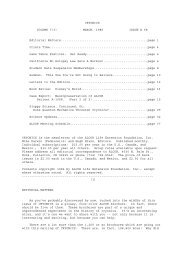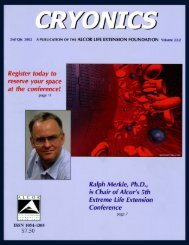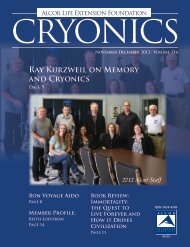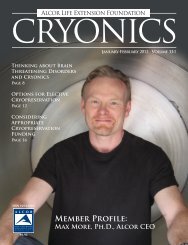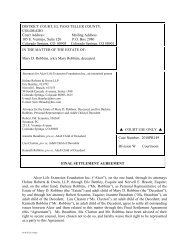CURTIS HENDERSON - Alcor Life Extension Foundation
CURTIS HENDERSON - Alcor Life Extension Foundation
CURTIS HENDERSON - Alcor Life Extension Foundation
- No tags were found...
You also want an ePaper? Increase the reach of your titles
YUMPU automatically turns print PDFs into web optimized ePapers that Google loves.
--------------------“THERE IS NOSUCH THINGAS FEEL-GOODCRYONICS”--------------------By Aschwin de WolfIcannot say that Curtis Henderson and I go back a long time,though I had heard about him quite a bit. In conversation withpeople who did know him well he was invariably praised as a ruthlessrealist who played a key role in eliminating one of the biggest mistakesin the history of cryonics: the practice of accepting third partyfunding in which living relatives or friends take on the ongoing financialresponsibility of keeping the patient in storage. The idea of thirdpartyfunding should not just be rejected because of its naiveté, thepractice also presents a danger to other, well-funded cryonics patients.No one likes to take an existing patient out of liquid nitrogen andburn or bury that person –not to speak of the public relations aspects.We would like to think that there are no hard decisions in cryonics, butas Curtis has reminded us, “there is no such thing as feel-good cryonics.”Unlike other cryonics pioneers such as Ev Cooper and MarceJohnson, Curtis has safely made it to long term care in liquid nitrogen.But the journey was not easy. In 1974 the New York Department ofPublic Health notified him that cryonics was in violation of the lawand the bodies of three Cryonics Society of New York (CSNY)patients had to be returned to their relatives. In 1979 cryonics suffereda major, additional blow when the nine patients of the CryonicsSociety of California were discovered to have thawed as a result ofinadequate or nonexistent funding by relatives, a big strike against the“pay as you go” practice that dominated cryonics up to that point.Curtis himself, after the demise of his own organization, CSNY, eventuallybecame an <strong>Alcor</strong> member, but switched to the CryoCare<strong>Foundation</strong> in the 1990s and, after this organization became inactive,finally joined the Cryonics Institute, where he is now cared for.It was at the Cryonics Institute where I met Curtis in person anumber of times. He seemed quite eager to see me and said that MikeDarwin had spoken highly of me. Curtis believed that it is importantfor young cryonics activists to learn from history and to that purposehe took me to his car and gave me a number of bound copies ofCryonics Reports. I persuaded him to sign these volumes. Curtis compliedbut could not understand why and said: “You should go to Saul, hewas the one doing all this.”Communicating with Curtis required patience and understanding.Years ago Curtis had suffered a stroke and was painfully self-consciousof its effects. I have reflected quite often on my encounters withCurtis and the fragility of human life. Curtis was still quite fortunatein having suffered relatively mild injury to the brain and having recoveredas a self-aware person with a lot of memories. Not all cryonicistshave been this fortunate, and in some cases, it cost them their lives.We live a lot longer today but this has also increased the chanceof personality-destroying brain diseases and insults. I think it is abouttime that we not only advocate cryonics for those who are written offby contemporary medicine, but also advocate that people should havethe liberty to specify that they want to be stabilized through the use oflow temperatures in case of extreme brain insults and progressivedementia. This was not necessary in the case of Curtis, but I think thathe would have welcomed this use of cryonics in the fight against thedebilitating effects of aging. ■www.alcor.org Cryonics/Third Quarter 200915



